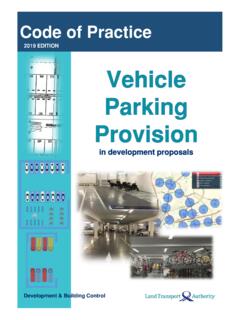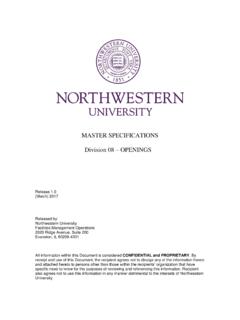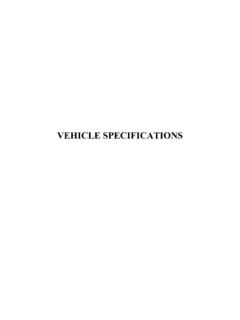Transcription of ACCESSIBILITY CODE 2019 - CORENET
1 code ON ACCESSIBILITY IN THE BUILT ENVIRONMENT 2019 The code on ACCESSIBILITY in the Built Environment 2019 is electronically published by the Building and Construction Authority. Building and Construction Authority, July 2019 Visit our friendly built environment website at code ON ACCESSIBILITY 2019 i C O N T E N T CONTENTS Chapter 1: ACCESSIBILITY In The Built Environment Scope 1 Definitions 2 Chapter 2: Provisions For ACCESSIBILITY ACCESSIBILITY in the Built Environment 5 Residential Development 11 Minimum Accessible Provisions 12 Inter-connectivity 15 Exemptions 16 Additions and Alteration Works 16 Chapter 3: Arriving At The Building Access to Buildings 17 Approach to Buildings 18 Passenger Alighting and Boarding Points 18 Taxi Shelters 20 Accessible Vehicle Parking 22 Kerb Ramps 27 Pedestrian Crossing 31 Chapter 4.
2 ACCESSIBILITY Around And Within The Building Horizontal Circulation Floor and Ground Surfaces 33 Accessible Routes, Corridors and Paths 35 Headroom 45 doors 46 Vertical Circulation Changes in Levels 59 Ramps 61 Handrails and Grab Bars 70 Passenger Lifts 73 Lifts Designated for Wheelchair Users 76 Platform Lifts and Wheelchair Stairlifts 80 Stairs 82 Stairs for the Ambulant Disabled 88 Chapter 5: Sanitary Provision General 89 Accessible Individual Washrooms 92 Accessible Water Closet Compartments 100 Water Closet Compartments for the Ambulant Disabled 104 code ON ACCESSIBILITY 2019 ii C O N T E N T Urinals for the Ambulant Disabled 108 Components in the Accessible Washroom 109 Bath Facilities 120 Accessible Changing Room 129 Wheelchair Transfer 132 Chapter 6.
3 Usage Of Space, Facilities And Elements Within The Building Illumination 135 Controls and Operating Mechanisms 136 Seating Spaces 140 Service and Information Counters 142 Drinking Fountains 144 Public Telephones 145 Eating Spaces 147 Hearing Enhancement Systems 151 Family-Friendly Facilities 152 Accessible Rooms, Guestrooms and Serviced Apartments 154 Chapter 7: Residential Development General Requirements 157 Entrances to Units 157 Bathrooms for Future Retrofitting 160 Switches and Socket Outlets 163 Chapter 8: Anthropometrics And Signage Anthropometrics and Space Allowances 164 International Symbol of Access for Persons with Disabilities 172 Directional Signs 175 Service Identification Signs 176 Signage 176 Appendix A: Design Guidelines for Family-Friendly Facilities Application 184 Recommended Facilities 184 Design Considerations 185 Appendix B: Design Guidelines for Older Persons Ageing and Safety 198 Falls in Home 198 Advantages of Considerate Design 199 Mobility 200 Prevention of Falls 200 Design Consideration 203 Top Ten Design Points 205 code ON ACCESSIBILITY 2019 iii C O N T E N T Appendix C.
4 Design Guidelines for Children With Disabilities Application 208 Interpretation 208 Handrails and Grab Bars 209 Seating Spaces 209 Drinking Fountains 210 Sanitary Provisions 210 Children s Reach Ranges 212 Lifts 213 Public Telephones 213 Canteens 213 Computer Rooms 213 Libraries 214 Appendix D: Design Guidelines for Persons With Visual Impairment Introduction 215 Visual Contrast in Building Interiors 216 Detectable Warning Surfaces 220 Application of Tactile Ground Surface Indicators 227 Appendix E: Design Guidelines for Parks And Open Spaces Graduated Difficulty of Access 233 Outdoor Recreation Access Routes 233 Viewing Areas 236 Outdoor Steps 238 Outdoor Facilities 240 Signage 244 Appendix F: Slip Resistance Of Floor Finishes Grading of Slip Resistance 247 Appendix G.
5 Keypad Design Requirements General 249 Keypads Used Inside Lift Cars 249 Keypad Design 249 Registration of Calls 250 Notices 250 code ON ACCESSIBILITY 2019 iv C O N T E N T List Of Figures Figure 1 Passenger Alighting and Boarding Point Figure 2 Taxi Shelter Figure 3 Angled Parking for Accessible Lots Figure 4 Parallel Parking for Accessible Lots Figure 5 Access Levels Figure 6 Directional Sign Figure 7 Examples of Signage at Accessible Parking Lot Figure 8 Kerb Ramp with Flared Sides Figure 9 Kerb Ramp with Returned/Continuous Kerbs Figure 10 Kerb Ramp with Built-Up/Extended Kerbs Figure 11 Figure 12 Parallel Kerb Ramp Kerb Ramps Location at Pedestrian Crossings Figure 13 Kerb Ramps Location on Island Figure 14 Gratings Figure 15 Dimension and Space Requirements for Accessible Corridors Figure 16 Width of Accessible Checkout Lane Figure 17 Access beside Turnstiles Figure 18 Trailing Bar Figure 19 Limits of Protruding Objects Figure 20 Freestanding Objects Mounted on Posts Figure 21 Resting Areas Figure 22 Overhead Hazard Figure 23 Clear Width of Doorways Figure 24 Markings on Glass doors Figure 25 Minimum Doorway Manoeuvring Space Figure 26 Minimum Doorway Manoeuvring Space for 2-way Swing Door Figure 27 Minimum Doorway Manoeuvring Space at Leading Edge of Door Leaf Figure 28 Manoeuvring Space of doors in a Series Figure 29 Examples of Door Handles Figure 30 Door Opening
6 Force Figure 31 Vision Panels and Kickplates Figure 32 Guardrails at Out-Swinging Automatic doors Figure 33 Contrasting Colour, Coloured Bands and Detectable Warning Surfaces on Ramps Figure 34 Ramps Figure 35 Level Landings and Edge Protection Figure 36 Ramps and Landings Figure 37 Handrail Extensions Figure 38 Sectional View of Edge Protections Figure 39 Handrails Figure 40 Braille and Tactile Markings on Lift Control Panels Figure 41 Grab bars in Lift Cars Figure 42 Lift for Wheelchair User Figure 43 Example of Platform Lift Figure 44 Example of Wheelchair Stairlift code ON ACCESSIBILITY 2019 v C O N T E N T Figure 45 Staircase Figure 46 Handrail Extensions Figure 47 Stair Detail Figure 48 Example of Accessible Toilets in School Figure 49 Detail of Accessible Individual Washroom Figure 50 Location of Jumbo Toilet Roll
7 Dispenser Figure 51 Detail of Larger Accessible Individual Washroom Figure 52 Accessible Water Closet Compartment within a Toilet Cluster Figure 53 Accessible Water Closet Compartment Figure 54 Water Closet Compartments for the Ambulant Disabled Figure 55 Urinal for the Ambulant Disabled Figure 56 Washroom Accessories Figure 57 Wash Basin for Person with Disabilities Figure 58 Water Closets Figure 59 Bathtub for Persons with Disabilities Figure 60 Alternative Layout Plan of Bathtub for Persons with Disabilities Figure 61 Roll-in Shower Stall for Wheelchair Users Figure 62 Example of Accessible Individual Washroom Layout with Shower Facility Figure 63 Symbol for Accessible Changing Room Figure 64 Accessible Changing Room Figure 65 Wheelchair Transfer: Diagonal Approach Figure 66 Wheelchair Transfer: Side/Parallel Approach Figure 67 Wheelchair Transfer: Frontal Approach Figure 68 Controls and Operating Mechanisms Figure 69 Examples of Tap Controls Figure 70 Wheelchair Spaces for Audience Seating Figure 71 Approach to Table or Counter Figure 72 Service and Information Counters Figure 73 Built-in Drinking Fountains Figure 74 Telephone Booth Figure 75 Seating Arrangements Figure 76 Table Dimensions Figure 77 Symbol of Access for People with Hearing Loss Figure 78 Family Car Parking Lot Figure 79 Example of Accessible Rooms in Hotels Figure 80 Residential Unit.
8 Minimum Doorway Width and Manoeuvring Space at Entrance Figure 81 Residential Unit: Corridors and Entrances Figure 82 Residential Unit: Ramp at Entrance Figure 83 Residential Unit: Width of Doorway at Right Angle to Corridor Figure 84 Wheelchair Space Allowances: Minimum Clear Floor Space Figure 85 Wheelchair Space Allowance: Minimum Clear Turning Space Figure 86 Typical Dimensions of Wheelchairs Commonly Used by Adults Figure 87 Reach Ranges: Forward Reach Without Obstruction Figure 88 Reach Ranges: Forward Reach Over Obstruction Figure 89 Reach Ranges: Side Reach Without Obstruction Figure 90 Reach Ranges: Side Reach Over Obstruction code ON ACCESSIBILITY 2019 vi C O N T E N T Figure 91 Positions Taken by a Wheelchair when Negotiating a Door in a Passageway Figure 92 Comfortable Walking Widths Figure 93 Symbol of Access for Persons with Disabilities Figure 94 Example of Symbols for Persons with Different Needs Figure 95 Directional Sign Figure 96 Directional Sign to Facility Figure 97 Service Identification Signs at Destinations Figure 98 Location of Door Signs on the Latch Side of doors Figure 99 Recommended Specifications for Braille on Signage Figure 100 Example of Raised Tactile and Braille Sign Figure A1 Water Closet for Young Children Figure A2 Urinal for Young Children Figure A3 Wash Basin for Young
9 Children Figure A4 Example of Fold-up Type Child Protection Seat Figure A5 Child Protection Seat in Water Closet Compartment Figure A6 Child Protection Seat and Diaper Changing Station in Accessible Individual Washroom Figure A7 Example of Fold-up Type Diaper Changing Station Figure A8 Example of Family Washroom with Child WC, Child Protection Seat and Diaper Changing Station Figure A9 Example of Accessible Family Washroom with Child WC, Child Protection Seat and Diaper Changing Station Figure A10 Example of Lactation Room Figure A11 Example of Lactation Room at Workplace Figure A12 Locker for Baby Carriages Figure B1 Examples of Rollator, Electric Wheelchair and Motorised Scooter Figure B2 Layout of House Suitable for the Aged Figure D1 Effective Luminance Contrast Figure D2 The Hue Circle Figure D3 Effective Hue Contrast Figure D4 Saturation Contrast Figure D5 Warning Indicators Figure D6 Directional Warning Indicators Figure D7 Application of Tactile Ground Surface Indicators at Pedestrian Crossings and Kerb Ramps Figure D8 Application of Tactile Ground Surface Indicators at Stairs, Steps.
10 Escalators and Passenger Conveyors Figure D9 Application of Tactile Ground Surface Indicators at flush Pedestrian Vehicular Way Figure D10 Tactile Guidance Strips Figure E1 Interconnected Facilities Figure E2 Resting Area Figure E3 Edge Protection for Access Route Figure E4 Clear Ground Space Figure E5 Unobstructed View Figure E6 Landings code ON ACCESSIBILITY 2019 vii C O N T E N T Figure E7 Outdoor Rinsing Showers Figure E8 Telescope Figure E9 Information Board Figure E10 Directional Sign Figure G1 Keypad Buttons List Of Tables Table 1 ACCESSIBILITY for Persons with Disabilities and Families with Young Children Table 2 Accessible Parking Lots Table 2A Accessible Parking Lots for Hospitals Table 3 Accessible Route Widths Table 4 Changes in Levels Table 5 Gradient and Length of Ramps Table 6 Minimum Clear Width of Door Openings for Residential Units Table 7 Height of Letters Table 8 Sizes of Symbols Table 9 Col


















